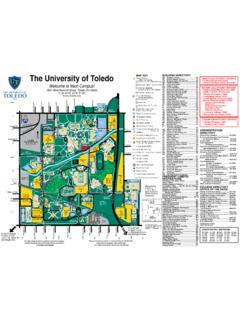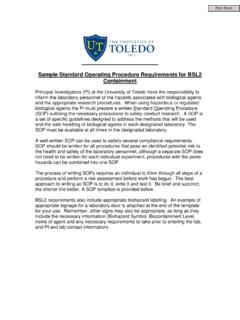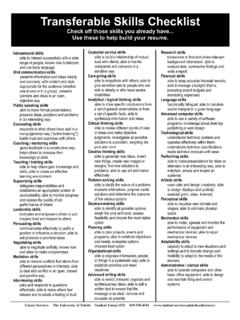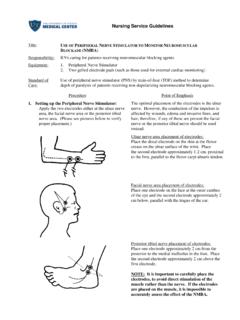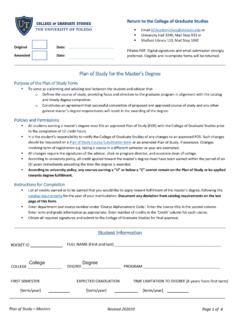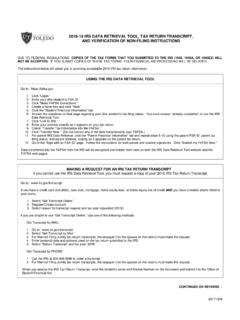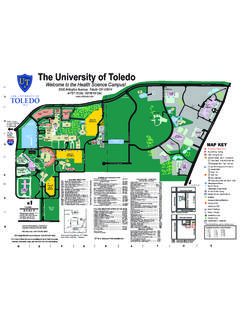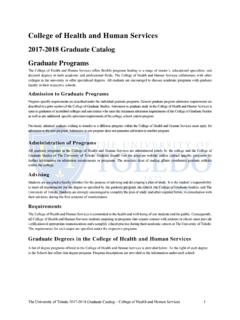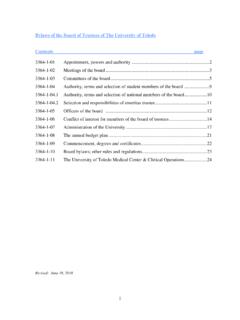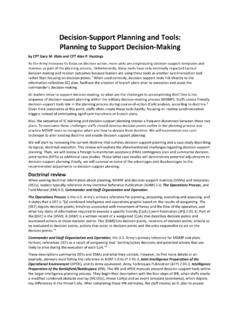Transcription of THEOPERATIONSPROCESS - University of Toledo
1 ADP 5- 0. THE OPERATIONS PROCESS. MAY 2012. DISTRIBUTION RESTRICTION: Approved for public release; distribution is unlimited. HEADQUARTERS, DEPARTMENT OF THE ARMY. This publication is available at Army Knowledge Online ( ). *ADP 5-0 (FM 5-0). Army Doctrine Publication Headquarters No. 5-0 (FM 5-0) Department of the Army Washington, DC, 17 May 2012. The Operations Process Contents Page PREFACE .. ii Definition and Purpose .. 1. Principles of the Operations Process .. 2. Activities of the Operations 6. Conclusion .. 16. GLOSSARY .. Glossary-1. REFERENCES .. References-1. Figures Figure 1. The operations process underlying logic ..iv Figure 2. The operations process .. 1. Table Table 1.
2 Preparation activities .. 11. DISTRIBUTION RESTRICTION. Approved for public release; distribution is unlimited. *This publication supersedes FM 5-0, dated 26 March 2010. i Preface Army Doctrine Publication (ADP) 5-0, The Operations Process, constitutes the Army's view on planning, preparing, executing, and assessing operations. (See figure 1 on page iv.). It accounts for the complex, ever-changing, and uncertain nature of operations and recognizes that a military operation is foremost a human undertaking. As such, this publication emphasizes the philosophy of mission command to include the central role of commanders (supported by their staffs) in driving the operations process.
3 To comprehend the doctrine contained in ADP 5-0, readers must first understand the foundations of unified land operations described in ADP 3-0, Unified Land Operations. Readers must also fully understand the principles of mission command described in ADP 6-0, Mission Command. For a detailed explanation of the operations process, readers should refer to Army Doctrine Reference Publication (ADRP) 5-0, The Operations Process. The principal audience for ADP 5-0 includes Army commanders, leaders, and unit staffs (officers, noncommissioned officers, and Soldiers). Commanders and staffs of Army headquarters serving as a joint task force or multinational headquarters should also refer to applicable joint or multinational doctrine concerning the range of military operations as well as joint or multinational forces.
4 Trainers and educators throughout the Army will also use this manual . Commanders, staffs, and subordinates ensure their decisions and actions comply with applicable , international, and, in some cases, host nation laws and regulations. Commanders at all levels ensure their Soldiers operate in accordance with the law of war and the rules of engagement. (See field manual [FM] 27-10.). ADP 5-0 uses joint terms where applicable. Selected joint and Army terms and definitions appear in both the glossary and the text. Terms for which ADP 5-0 is the proponent publication (the authority) are marked with an asterisk (*) in the glossary. Definitions for which ADP 5-0 is the proponent publication are boldfaced in the text.
5 These terms and their definitions will be in the next revision of FM 1-02. For other definitions shown in the text, the term is italicized and the number of the proponent publication follows the definition. ADP 5-0 applies to the Active Army, Army National Guard/Army National Guard of the United States, and United States Army Reserve unless otherwise stated. The proponent of ADP 5-0 is the United States Army Combined Arms Center. The preparing agency is the Combined Arms Doctrine Directorate, United States Army Combined Arms Center. Send comments and recommendations on a DA Form 2028. (Recommended Changes to Publications and Blank Forms) to Commander, Army Combined Arms Center and Fort Leavenworth, ATTN: ATZL-MCK-D (ADP 5-0), 300.
6 McPherson Avenue, Fort Leavenworth, KS 66027-2337; by e-mail to or submit an electronic DA Form 2028. ii ADP 5-0 17 May 2012. ACKNOWLEDGEMENT. Cover photo courtesy of the Army at Figure 1. The operations process underlying logic iv ADP 5-0 17 May 2012. This publication defines and describes the operations process. It provides principles commanders and staffs consider to effectively plan, prepare, execute, and continuously assess operations. DEFINITION AND PURPOSE. 1. The Army's framework for exercising mission command is the operations process . the major mission command activities performed during operations: planning, preparing, executing, and continuously assessing the operation.
7 Commanders, supported by their staffs, use the operations process to drive the conceptual and detailed planning necessary to understand, visualize, and describe their operational environment;. make and articulate decisions; and direct, lead, and assess military operations. Figure 2. The operations process 2. The activities of the operations process are not discrete; they overlap and recur as circumstances demand. Planning starts an iteration of the operations process. Upon completion of the initial order, planning continues as leaders revise the plan based on changing circumstances. Preparing begins during planning and continues through execution. Execution puts a plan into action by applying combat power to seize, retain, and exploit the initiative to gain a position of relative advantage.
8 Assessing is continuous and influences the other three activities. 3. Both the commander and staff have important roles within the operations process. The commander's role is to drive the operations process as depicted in figure 2. The 17 May 2012 ADP 5-0 1. ADP 5-0. staff's role is to assist commanders with understanding situations, making and implementing decisions, controlling operations, and assessing progress. In addition, the staff assists subordinate units (commanders and staffs), and keeps units and organizations outside the headquarters informed throughout the operations process. (ATTP discusses the duties and responsibilities of the staff in detail.). PRINCIPLES OF THE OPERATIONS PROCESS.
9 4. The philosophy of mission command guides commanders, staffs, and subordinates as they plan, prepare, execute, and assess operations. Mission command requires an environment of mutual trust and shared understanding among commanders, staffs, and subordinates. It requires a command climate in which commanders encourage subordinates to accept prudent risk and exercise disciplined initiative to seize opportunities and counter threats within the commander's intent. Through mission orders, commanders focus their instructions on the purpose of the operation rather than on the details of how to perform assigned tasks. Doing this minimizes detailed control and allows subordinates the greatest possible freedom of action.
10 Finally, when delegating authority to subordinates, commanders set the necessary conditions for success by allocating appropriate resources to subordinates based on assigned tasks. 5. Commanders and staffs use the operations process to integrate numerous tasks that are executed throughout the headquarters and with subordinate units. Commanders must organize and train their staffs and subordinates as an integrated team to simultaneously plan, prepare, execute, and assess operations. In addition to the principles of mission command discussed in ADP 6-0, commanders and staffs consider the following principles for the effective use of the operations process: Commanders drive the operations process.
